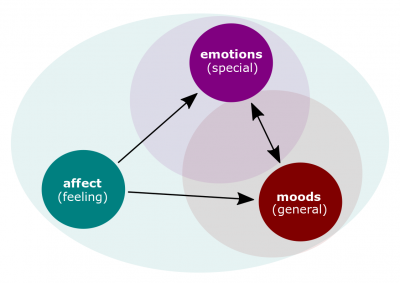Difference between revisions of "Affect"
| Line 1: | Line 1: | ||
[[File:Emotions-vs-moods.png|400px|thumb|right|[[Affect]]]][[Affect]] is a broad range of feelings that people experience. | [[File:Emotions-vs-moods.png|400px|thumb|right|[[Affect]]]][[Affect]] is a broad range of feelings that people experience. | ||
| + | ==Definitions== | ||
| + | According to [[Organizational Behavior by Robbins and Judge (17th edition)]], | ||
| + | :[[Affect]]. A broad range of feelings that people experience. | ||
| − | == | + | ==Related concepts== |
*[[Positive affect]]. A mood dimension that consists of specific positive emotions such as excitement, enthusiasm, and elation at the high end. | *[[Positive affect]]. A mood dimension that consists of specific positive emotions such as excitement, enthusiasm, and elation at the high end. | ||
*[[Negative affect]]. A mood dimension that consists of specific negative emotions such as nervousness, stress, and anxiety at the high end. | *[[Negative affect]]. A mood dimension that consists of specific negative emotions such as nervousness, stress, and anxiety at the high end. | ||
Revision as of 04:59, 26 November 2018
Affect is a broad range of feelings that people experience.
Definitions
According to Organizational Behavior by Robbins and Judge (17th edition),
- Affect. A broad range of feelings that people experience.
Related concepts
- Positive affect. A mood dimension that consists of specific positive emotions such as excitement, enthusiasm, and elation at the high end.
- Negative affect. A mood dimension that consists of specific negative emotions such as nervousness, stress, and anxiety at the high end.
- Affect intensity. Individual differences in the strength with which individuals experience their emotions.
